The Museum Collections
Introduction
I. History and Art Collection
1. Icons of the 14th – 19th centuries
icons of the 14th – 17th century
2. Jewelry art of the 14th – 20th century
jewelry art of the 14th – 17th century
jewelry art of the 18th – 19th century
the european silver 14th - 19th centuries
3. Small-size sculptures (works of metal, wood, bone)
XI – the beginning of the XX century
Small-size sculptures 11th – 17th century
Small-size sculptures 18th – early 20th century
enamel of Troitza masters 15-8th – early 20th century
5.Embroidery, lace, textiles of the 14th - early 20th century
icon and ornamental embroidery
gold and silver lace
6.Painting of the 18th – 21st centuries
painting of the 18th – 19th centuris
painting of the 20th – 21st centuris
II.Manuscripts and old printed books of the 14th – 17th century
IV.Lithography of the 18th – 19th century
V.Numismatics
VI.Medals of the 18th - early 20th century
VIII.Archeology collection
IX. Russian folk and applied and decorative art of the 17th – 21st c.
1. Artistic wood
folk carved and painted wood
wooden toys
house carving of Sergiev Posad
Khokhloma and Gorodets painting
2. Artistic textiles
embroidery and weaving
printed textiles and lace
Russian shawls
folk costumes
folk garments
printed cotton kerchiefs
|
Folk costumes of 19th - the beginning of 20th century(P. 1)
|
The Sergiev-Posad museum possesses the exclusive collection of a female suit of northern and average regions of the European part of Russia. All exhibits are united by saturated colour, character of decoration and breed. But at the same time each region, it is frequent even district, had the features. The essential detail of Russian clothes was made by a shirt. The homespun woollen skirt dressed on a long shirt from a white canvas. The sundress dressed on a shirt. Maiden clothes (Simbirsk province) of Middle Povolzhje are presented in a museum by the dress which consists of shirts, a sundress and a belt with a pocket.
The wedding suit of the Novgorod province includes a white shirt, a dark blue homespun linen sundress of direct breed, a wavering belt. The bride supplemented the dress with beads. In the Arkhangelsk region petticoats and white linen shirts elegantly trimed. The woman had the right to go without a sundress only to a harvest-time in the field. The canvas shirt of region of the river of Vychegda has easy furnish round a collar, large strips of woven pattern on shoulders, a wide fringing of a hem. The suit from Malmyzhsky district of Vyatsky region, dressed by the bride-oldbeliever on betrothal, consists of a shirt, a sundress, a belt and breast ornaments.
|
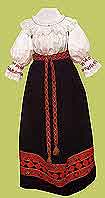
Maiden wedding costume. Early 20th century. Novgorod region |
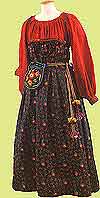
Maiden celebratory costume. 1910-1920th. Ulyanovsk region |

Female shirt. 19thcentury. Arkhangelsk region. Kargopol |

Female wedding costume. Late 19th – early 20th century. Kirov region |
Skilled workers of the Velikiy Ustuge town of the Vologda region made the costumes especially decorative. Pearls of museum collection are two unique costumes of 1870s years come from Solvychegodsk district of the Vologda province. It is the yellow costume with boldly embroidered female figures reminding fur-trees. Colour scale of the costume very bright: on the yellow background - scarlet, dark blue, red, green and blue stains of figures, on the apron hem there is a wide decorative frieze, and the scarlet frill from a woollen factory fabric finishes costume furnish.
The second costume newly married of Solvychegodsk district is similar in a set of details to described above one, and close on breed, slightly differing in details. Traditional for country clothes contrasting red and white colours prevail, however, in its colour solution. In the pattern of the bib are images of the female figures having genital symbolics and reflecting representations of ancient Slavs about a pagan deity - Mokosha. The winter celebratory female costume included a sound fur coat, usually from a sheepskin. For a cold season was peasant broadcloth, or cloth caftan. Such costume of the Nikolsky district of the Vologda province consists of peasant broadcloth, shirts, the sundress, the belt and a woollen shawl.
|

Costume newly married. 1870s. Vologda region. District of Velikiy Ustyug. Flax. Wool. Embroidery. Weaving. |

Costume newly married. 1870-1880s.e Vologda region. District of Velikiy Ustyug |
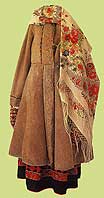
Female celebratory fur coat. Late of 19th - early of 20th century. Russian North. |
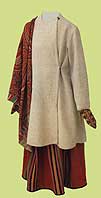
Female celebratory costume. Early of 20th century. Vyatsky region |
One of the best in the country of collections of wedding South Russian costumes is stored in Sergiev-Posad museum. The maiden dress from the Tambov province consists of a shirt, homespun woollen skirt, short breast clothes – “shushpan” and a headdress. Researchers of an Old Russian costume consider homespun woollen skirt as the most ancient type of lady's wear. The marriageable girl from Skopinsk district of the Ryazan province wore the special dress in which colour scale the dominant role was played by white colour of a homespun woollen or linen cloth.
Such costume usually decorated neck and breast ornament. The costume of Kadomsky district of the Ryazan region instead of “shushpan” has “navershnick” - a sleeveless jacket which dressed on over a shirt and homespun woollen skirt. Its furnish is extraordinary rich: on a white background of a canvas red strips woven pattern, an insert of a red calico and colour wattled laces.
In a female costume of the Penza region admires unusual chinure, sonority of a colour score and a maximum richness of colour, where bright greens mark out near to traditional red colour, enriching costume scale. Weaving on the Penza costume excel by thin worked ornament with very archaic motives.
|
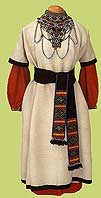
Maiden costume. Early 20th century. Ryazan region |

Female costume. 19thcentury. Ryazan region. Kadomsky district. Flax. Wool. Red calico. Embroidery. Weaving |
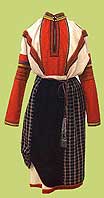
Maiden celebratory costume. Early 20th century. Tambov province. Krasnaya Dubrava village |
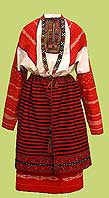
Costume newly married. 1920s. Penza region |
Lady's wears of the Voronezh earth are harmonious. So the strips of black embroidery executed in good style and skill are imposed on a white canvas and an apron in a costume of a newly married shirt. To a costume the wide colourful woven belt and an original necklace from a wattled cord with the circles, called “gribatkha”, relied. The head was decorated by the closed headdress - "sorokha". The linen shirt for the groom was embroidered in pair to a wedding female costume. Everyday sundresses made of homespun coarse motley or heel-taps in the Tver province.
The Kalinin’s linen white clothes with a shirt which named “nasova”, have kept ancient traditions of breed and furnish. The shirt collar is decorated by a red chintz. In some places of the South of Russia the sundress is not only maiden, but also lady's wear. In Kursk province a wedding costume consisted of a shirt, a sundress-fur coat from scarlet damask, an apron one or several belts, a headdress and breast ornaments. Man's wedding costumes did not differ a variety. It consisted of velveteen cloth or linen trousers and a bright silk or sateen shirt.
|
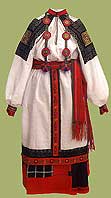
Female wedding costume. Early 19th century. Voronezh region. Wool. Flax. Gold threads. Embroidery. Weaving |
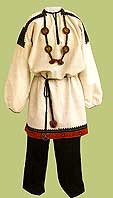
Man's wedding costume. Early 19th century. Voronezh region |

Female costume. 19thcentury. Tver region. Nelidovsky district |
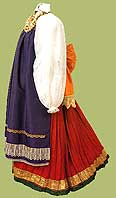
Female wedding costume. Early 19th century. Kursk region |
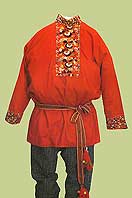
Man's wedding costume. Early 20th century. Kirov region |
|


